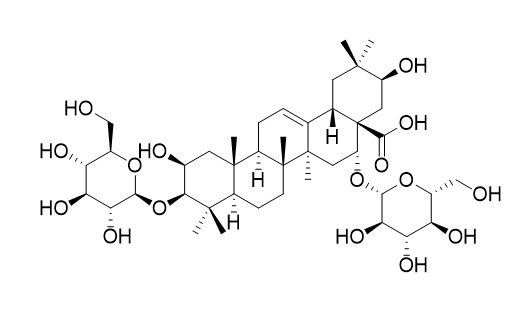Platycogenin ACAS# 1459719-53-9 |

Quality Control & MSDS
Package In Stock
Number of papers citing our products

| Cas No. | 1459719-53-9 | SDF | Download SDF |
| PubChem ID | N/A | Appearance | Powder |
| Formula | C42H68O16 | M.Wt | 829.0 |
| Type of Compound | Triterpenoids | Storage | Desiccate at -20°C |
| Solubility | Soluble in Chloroform,Dichloromethane,Ethyl Acetate,DMSO,Acetone,etc. | ||
| General tips | For obtaining a higher solubility , please warm the tube at 37 ℃ and shake it in the ultrasonic bath for a while.Stock solution can be stored below -20℃ for several months. We recommend that you prepare and use the solution on the same day. However, if the test schedule requires, the stock solutions can be prepared in advance, and the stock solution must be sealed and stored below -20℃. In general, the stock solution can be kept for several months. Before use, we recommend that you leave the vial at room temperature for at least an hour before opening it. |
||
| About Packaging | 1. The packaging of the product may be reversed during transportation, cause the high purity compounds to adhere to the neck or cap of the vial.Take the vail out of its packaging and shake gently until the compounds fall to the bottom of the vial. 2. For liquid products, please centrifuge at 500xg to gather the liquid to the bottom of the vial. 3. Try to avoid loss or contamination during the experiment. |
||
| Shipping Condition | Packaging according to customer requirements(5mg, 10mg, 20mg and more). Ship via FedEx, DHL, UPS, EMS or other couriers with RT, or blue ice upon request. | ||
| Description | Reference standards. | |||||

Platycogenin A Dilution Calculator

Platycogenin A Molarity Calculator
| 1 mg | 5 mg | 10 mg | 20 mg | 25 mg | |
| 1 mM | 1.2063 mL | 6.0314 mL | 12.0627 mL | 24.1255 mL | 30.1568 mL |
| 5 mM | 0.2413 mL | 1.2063 mL | 2.4125 mL | 4.8251 mL | 6.0314 mL |
| 10 mM | 0.1206 mL | 0.6031 mL | 1.2063 mL | 2.4125 mL | 3.0157 mL |
| 50 mM | 0.0241 mL | 0.1206 mL | 0.2413 mL | 0.4825 mL | 0.6031 mL |
| 100 mM | 0.0121 mL | 0.0603 mL | 0.1206 mL | 0.2413 mL | 0.3016 mL |
| * Note: If you are in the process of experiment, it's necessary to make the dilution ratios of the samples. The dilution data above is only for reference. Normally, it's can get a better solubility within lower of Concentrations. | |||||

Calcutta University

University of Minnesota

University of Maryland School of Medicine

University of Illinois at Chicago

The Ohio State University

University of Zurich

Harvard University

Colorado State University

Auburn University

Yale University

Worcester Polytechnic Institute

Washington State University

Stanford University

University of Leipzig

Universidade da Beira Interior

The Institute of Cancer Research

Heidelberg University

University of Amsterdam

University of Auckland

TsingHua University

The University of Michigan

Miami University

DRURY University

Jilin University

Fudan University

Wuhan University

Sun Yat-sen University

Universite de Paris

Deemed University

Auckland University

The University of Tokyo

Korea University
- Peltatoside
Catalog No.:BCN9973
CAS No.:23284-18-6
- Terpinyl acetate
Catalog No.:BCN9972
CAS No.:80-26-2
- Vescalagin
Catalog No.:BCN9971
CAS No.:36001-47-5
- Butyric acid
Catalog No.:BCN9970
CAS No.:107-92-6
- Psoromic acid
Catalog No.:BCN9969
CAS No.:7299-11-8
- 4-Ethoxycoumarin
Catalog No.:BCN9968
CAS No.:35817-27-7
- Genistein 7-O-glucuronide
Catalog No.:BCN9967
CAS No.:38482-81-4
- Oxyacanthine sulfate
Catalog No.:BCN9966
CAS No.:6183-91-1
- Cubebin
Catalog No.:BCN9965
CAS No.:1242843-00-0
- 2,3-Dehydrosilybin B
Catalog No.:BCN9964
CAS No.:142796-24-5
- 4'-Methylchrysoeriol
Catalog No.:BCN9963
CAS No.:4712-12-3
- Aegineoside
Catalog No.:BCN9962
CAS No.:752209-48-6
- 9-Methyl-9-azabicyclo[3.3.1]nonan-3-one
Catalog No.:BCN9975
CAS No.:552-70-5
- AT101
Catalog No.:BCN9976
CAS No.:866541-93-7
- omega-Benzoyl oxyphloracetophenone
Catalog No.:BCN9977
CAS No.:65982-77-6
- Henricine
Catalog No.:BCN9978
CAS No.:107783-46-0
- Harmol
Catalog No.:BCN9979
CAS No.:487-03-6
- (-)-Verbenone
Catalog No.:BCN9980
CAS No.:1196-01-6
- trans-Beta-Apo-8'-carotenal
Catalog No.:BCN9981
CAS No.:1107-26-2
- 4',6,7-Trimethoxyisoflavone
Catalog No.:BCN9982
CAS No.:798-61-8
- (R,S)-Equol
Catalog No.:BCN9983
CAS No.:66036-38-2
- Farnesol
Catalog No.:BCN9984
CAS No.:4602-84-0
- 4'-Methoxyflavanone
Catalog No.:BCN9985
CAS No.:97005-76-0
- 1,3-Diphenyl-2-propen-1-one
Catalog No.:BCN9986
CAS No.:94-41-7
Influence of sulfur fumigation on glycoside profile in Platycodonis Radix (Jiegeng).[Pubmed:27385975]
Chin Med. 2016 Jul 6;11:32.
BACKGROUND: Over recent decades, sulfur fumigation is becoming abused in processing some freshly harvested herbs used as both medicine and food, although it has been questioned whether sulfur fumigation will change the efficacy and safety of the herbs. One of the herbs commonly processed by sulfur fumigation is Platycodonis Radix (Jiegeng in Chinese). Glycosides are the main bioactive components of Jiegeng. Up to the present, no study has been carried out to evaluate the impact of sulfur fumigation on glycoside profile of Jiegeng. METHODS: A rapid and versatile ultra-high performance liquid chromatography coupled with ultra-high resolution quadrupole time-of-flight mass spectrometry (UHPLC UHD Q-TOF MS/MS) method was developed for comprehensive analysis of the glycoside profiles of sulfur-fumigated and air-dried Jiegeng samples. RESULTS: Twenty-three glycosides were detected in air-dried and sulfur-fumigated Jiegeng samples. After sulfur fumigation, the peak heights of eight glycosides, namely Platycogenin A, platycodin D, platycodin D2, platycodin D3, polygalacin D, polygalacin D2, deapio-platycodin D and 3''-O-acetylplatycodin D2, remarkably decreased; while peak heights of five glycosides, namely syringin, lobetyolin, platycoside E, deapio-platycodin D2 and deapio-platycoside E, slightly increased; in addition, peaks of ten glycosides, platycodin A, platycodin C, platycodin V, platycoside C, 16-oxoplatycodin D, 2''-O-acetylpolygalacin D, 2''-O-acetylpolygalacin D2, 3''-O-acetylpolygalacin D, 3''-O-acetylpolygalacin D2, and platycogenic acid B, disappeared. CONCLUSION: Sulfur fumigation caused significant changes of glycoside components of Jiegeng. Further investigations are warranted to explore how these chemical changes occurred and whether these changes would affect the efficacy and safety of Jiegeng.


